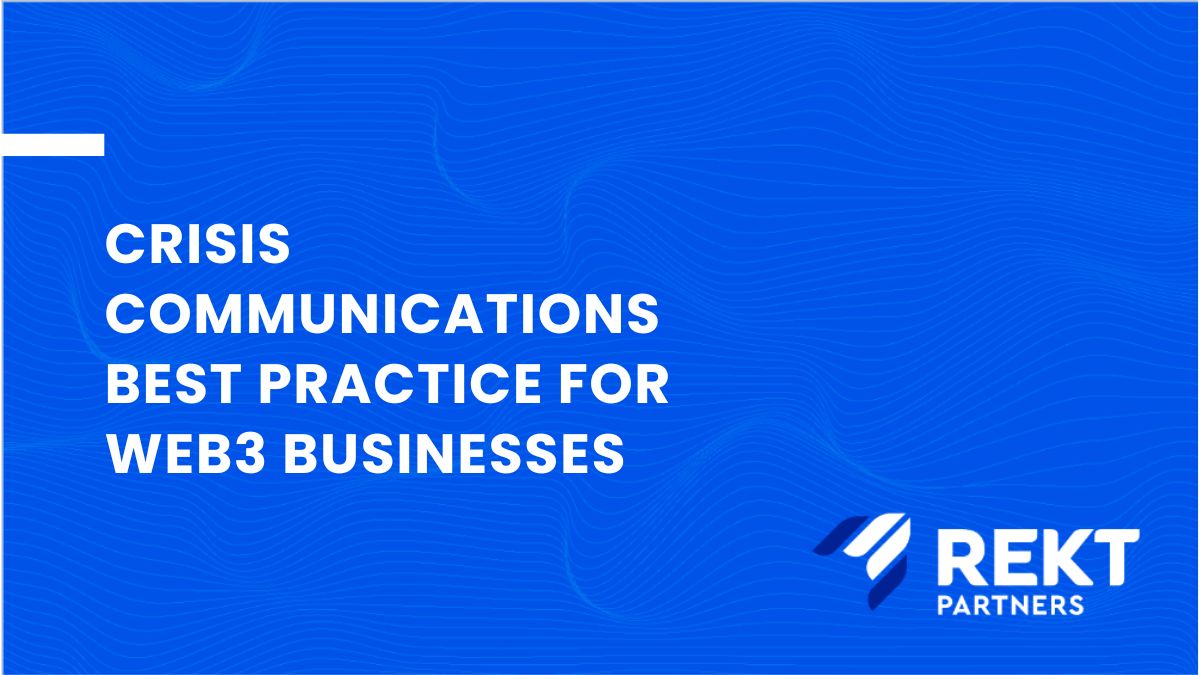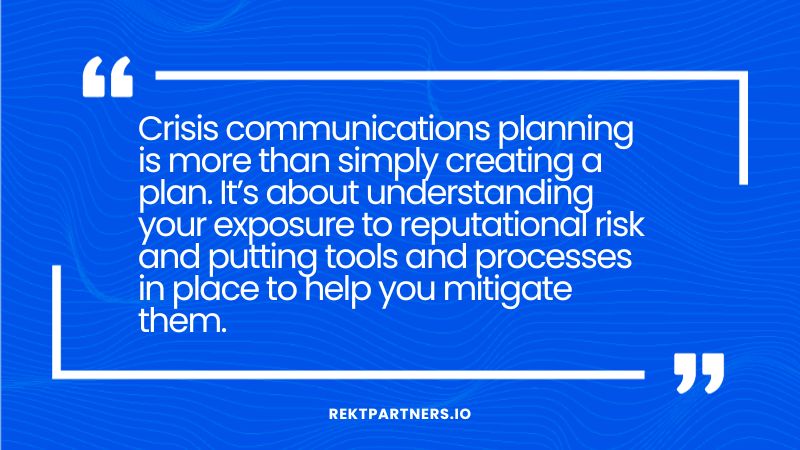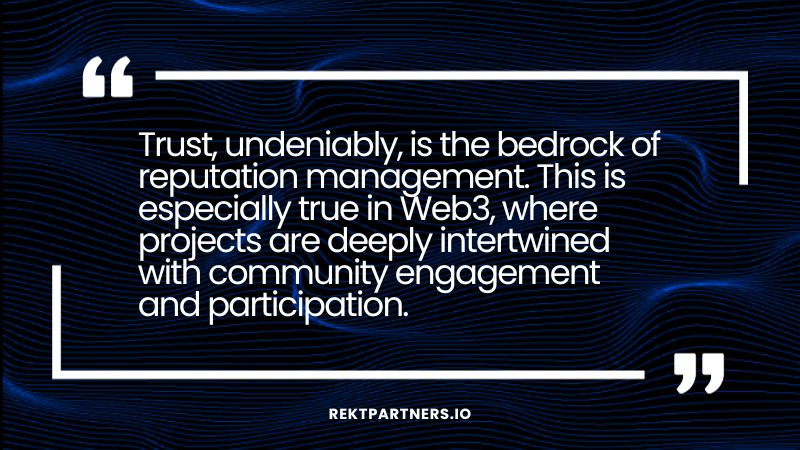Navigating the Storm: Effective Crisis Communications for Web3 Businesses
- Jenny Hurley-Flynn
- September 20, 2023
- Crisis communications
- 0 Comments

Understanding the Importance of Crisis Communications in the Web3 Era
Web3 isn’t just the future; it’s the wild frontier of the digital age. Headlines scream about new Web3 crises — including hacks, lawsuits, and regulatory misdemeanours — on an almost daily basis, creating massive crisis communications challenges for Web3 brands.
In this ever-shifting landscape, crisis planning isn’t optional — it’s survival. Mishandle a crisis, and a Web3 venture could easily crash, dragging its user base into financial chaos.
As experts in providing strategic communications consultancy to blockchain, Web3 and fintech businesses, we understand the pressure to be seen and heard. But focussing all communications resources on promotion at the expense of reputation protection leaves projects overly exposed to reputational risk.
Research from the likes of PwC and Oxford Metrica has repeatedly shown that strong crisis responses result in retained — or even growth in — shareholder value. At a time when VC funding in Web3 is at multi-year lows, protecting existing investments while rebuilding investors’ trust in the sector is critical, and proactive reputational risk management is an important part of the puzzle.
This blog explores how Web3 businesses can adopt crisis communications best practices in order to proactively manage risk and minimise reputational damage. While too often ignored, we see this as the cornerstone of long-term survival in a Web3 era.
Crisis Planning: The Foundation of Effective Crisis Communications

If there’s one thing you can accurately predict when starting a new Web3 project, it’s that — sooner or later — you will experience some kind of crisis. It might be a technical outage that is easily remedied or a full-blown existential crisis.
Either way, crisis planning can help you respond quickly in the heat of the moment, which is absolutely critical in the Web3 space where users potentially have a huge amount at stake.
Crisis communications planning is more than simply creating a plan (although that’s, of course, very important). It’s about understanding your exposure to reputational risk and putting tools and processes in place to help you mitigate them.
Without truly understanding your risk landscape, you’re either flying blind, ignorant to the risks that could impact you, or in a permanent state of panic, losing sleep night after night thinking about all the ‘what if’ scenarios. Neither are sustainable strategies. Taking a proactive approach to crisis planning will not only help you sleep better but will ultimately protect your business’ bottom line in the worst-case scenarios.
How to Create a Crisis Communications Plan
The first step any blockchain or Web3 business should take in its crisis planning journey is to create a reputational risk register. This maps out the key risks an organisation faces based on the likelihood of them occurring and the reputational impact they would have if they were to happen.
Crucially, this cannot be developed by a communications team in isolation. To truly understand all reputation risks a business faces this has to be developed in lockstep with other critical teams within the business, from legal, HR, to product and marketing. The resulting register is a critical early warning tool for reputational risks in your business.
Once you know what your most likely and highest impact risk events are, then you can start implementing a crisis communications strategy.
This all starts with creating a crisis communications plan. A well-designed crisis plan can help businesses respond quickly and effectively to a crisis, minimising damage not only to their reputations, but also to their operations. According to Capterra, 98% of business leaders who have activated their crisis communications plan say it was effective and 77% say it was very effective.
There are several key elements that Web3 businesses should incorporate in their crisis communications plans. These include:
- Crisis communications team: decide who is going to be responsible for handling communications during a crisis. Tempting though it is for everyone to start piling into a Discord channel and providing seemingly helpful updates, a lack of coordination and messaging control leads to frequent contradictions and confusion for users.
- Crisis handling processes: establish how the communications team is going to operate during a crisis, including expected response times (e.g. if it’s necessary to react within minutes that requires significant infrastructure and preparation), and how the communications team is going to interact with leadership and other critical teams (e.g. legal, security, engineering and marketing). This includes defining which internal systems the communications team will use to coordinate a crisis. Action lists are also important to help ensure critical actions are not forgotten.
- Template statements: draft template holding statements aligned to your reputational risk register. Having template statements drafted for key risks across your main channels (such as X, Discord, Telegram, company blog and status page) will vastly improve the speed and quality of communications during a crisis.
- Audience mapping: understand who your main audience groups are in a crisis. These are likely to include your community and users, employees, partners and, where applicable, regulators and other government authorities.
- Company voices: define who will be the leading voices of your company during a crisis. Social media posts from CEOs, founders and other leading figures can help amplify the reach of your crisis messaging while also adding a more human touch to your crisis communications.
The plan doesn’t have to be long. In fact, we recommend that crisis communications plans are kept as short as possible while retaining all the key elements as highlighted above. Your plan has to be able to be accessed and useable at a moment’s notice via a phone or tablet when you’re away from your desk.
Writing a crisis communications plan is a crucial step in building crisis preparedness, but it’s not enough to safeguard your reputation during a crisis. Everyone in your organisation responsible for communications needs to know how to apply the plan under the intense pressure of a crisis.
This means that crisis plan training is critical. We strongly recommend that businesses enact full-blown crisis simulations in a testnet environment on a regular basis to allow teams to experience an as-live crisis in a safe environment to hone their skills. Crisis training also helps with evaluating your plan to ensure it remains fit for purpose.
Building Trust and Transparency: Key Elements of Crisis Communications

In the rapidly evolving world of Web3 and crypto, high-profile collapses, deceptive “rug pulls”, and a constant wave of phishing attacks have cast a shadow over the industry, leading to a palpable trust deficit. This is pretty ironic given that the whole premise of blockchain is that it’s a trustless system, an enabler of transparency.
Trust, undeniably, is the bedrock of reputation management. This is especially true in Web3, where projects are deeply intertwined with community engagement and participation. A strong foundation of trust not only propels a brand to new heights during prosperous times but also acts as a protective shield, preventing it from crumbling during adversities.
When faced with a crisis, the way in which a brand communicates becomes the litmus test of its integrity. To uphold and possibly strengthen the trust of its community, Web3 brands must adopt a transparent communication strategy. This means providing timely and consistent updates, acknowledging any lapses or oversights, and, most importantly, owning up to and potentially compensating for any misdeeds.
By adopting a transparent approach, Web3 businesses are much more likely to maintain the trust of their users. This not only helps to limit the reputational damage of a crisis, but could potentially help boost the brand’s reputation over the longer term.
The Role of Social Media: Strategies for Effective Engagement in a Crisis
Social media is the lifeblood of any Web3 business. A lot of Web3 users rely heavily on X, Discord and Telegram for their industry news and community announcements. Updating these channels with helpful information — at speed — is therefore key for keeping users engaged during a crisis and minimising any reputational fallout
Providing regular updates on social media channels during a crisis helps businesses to communicate quickly and proactively. This could include sharing updates on the steps taken to resolve the crisis, providing information on any changes to operations or services, and addressing any concerns or questions raised by stakeholders.
Aside from disseminating messages, social media is also a vital monitoring tool. By “listening” to what users are saying on social channels, brands can quickly learn of and adapt to emerging or developing issues.
Social media should be handled by a dedicated group of people during a crisis. The last thing you want is different members of your company sharing different messages. Social media handlers should be defined within your crisis communications plan.
Conclusion: Best Practices for Effective Crisis Communications for Web3 Projects
In conclusion, crisis communication and proactive reputation management should be a top priority for Web3 projects. Businesses need to have a well-defined crisis communications strategy in place that is aligned with business strategy and other critical teams. A well-defined crisis strategy means you need regular reputational risk audits, a crisis communications plan and an ongoing programme of crisis communications training.
Trust and transparency are crucial in crisis communications, and businesses should be proactive in communicating with stakeholders and engaging with them through various channels. Social media plays a vital role in crisis communications, and businesses should use it effectively to monitor and respond to mentions and comments, provide regular updates, and address any concerns or questions.
In today’s world where information spreads rapidly and can have a lasting impact, businesses need to be prepared to manage and mitigate the impact of a crisis on their reputation and operations. By following the best practices outlined in this blog post, businesses can effectively navigate through a crisis and safeguard their reputations.
To learn more about REKT Partners’ crisis communications services, get in touch.
